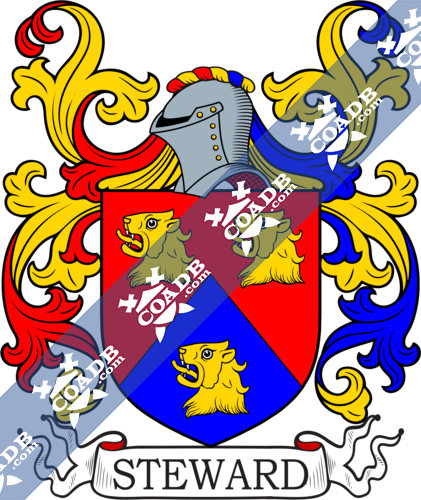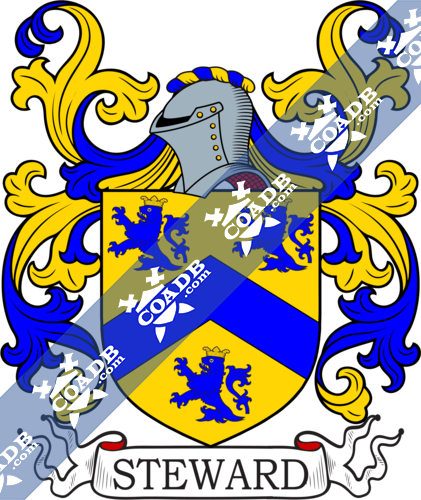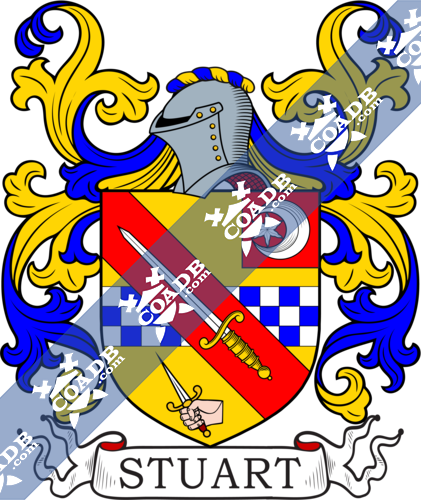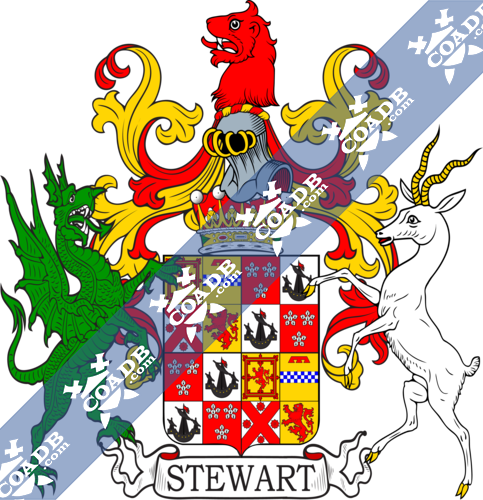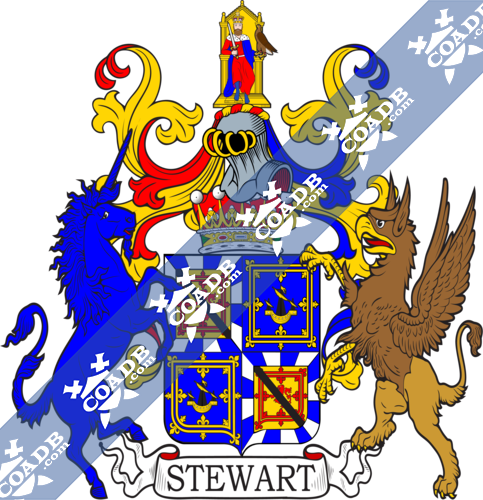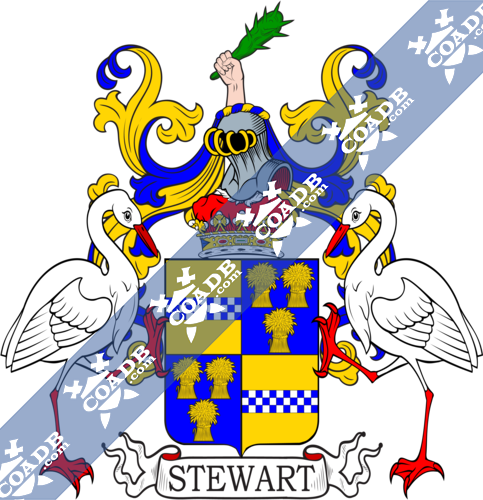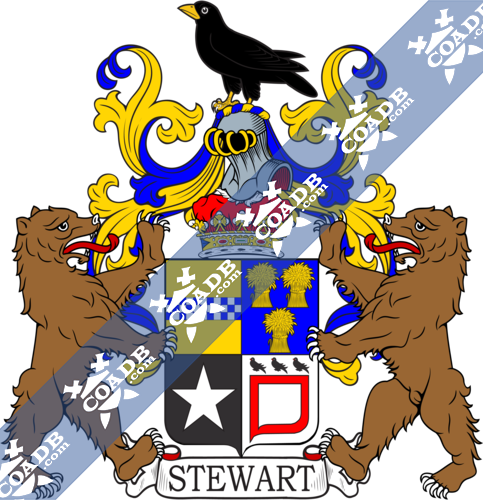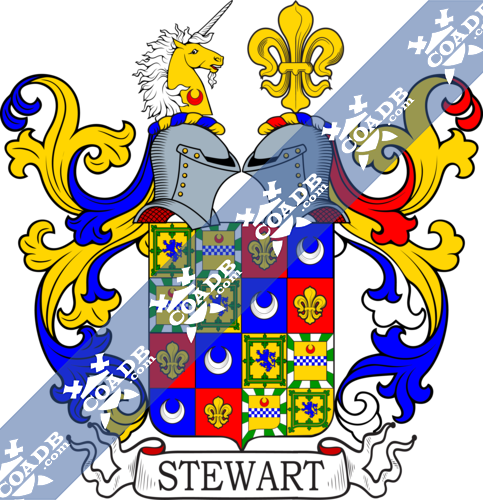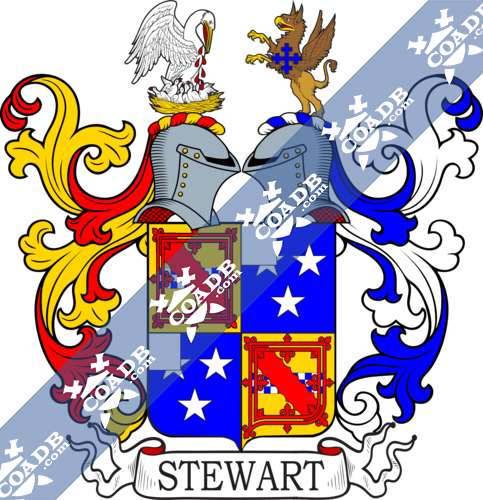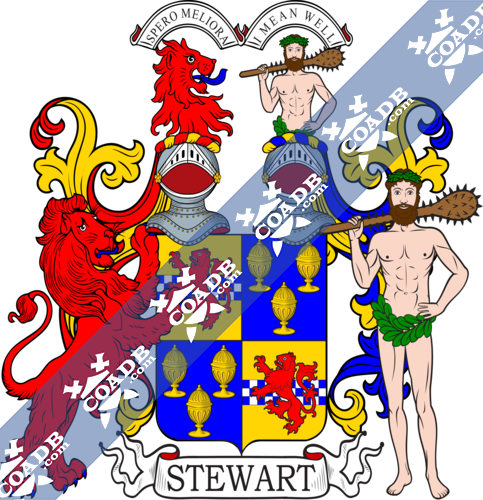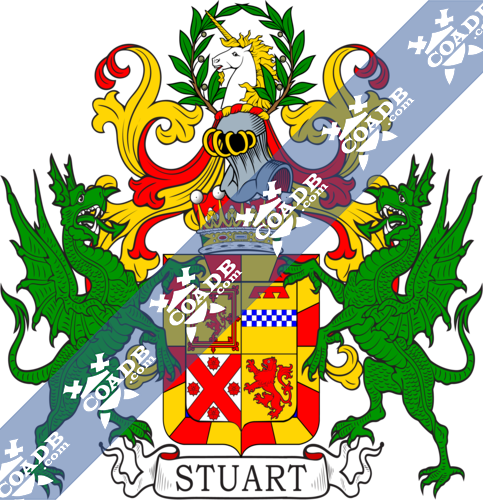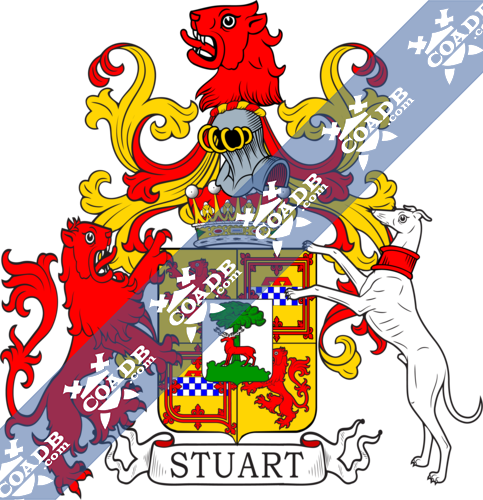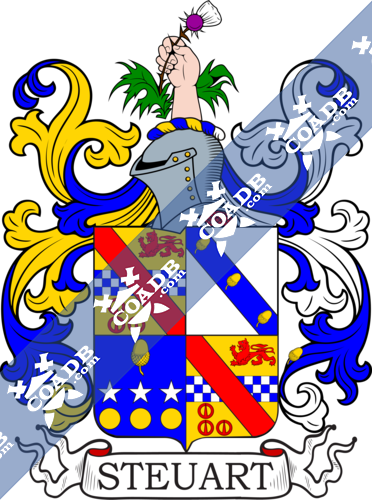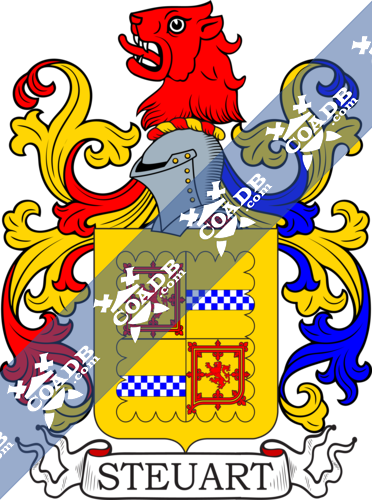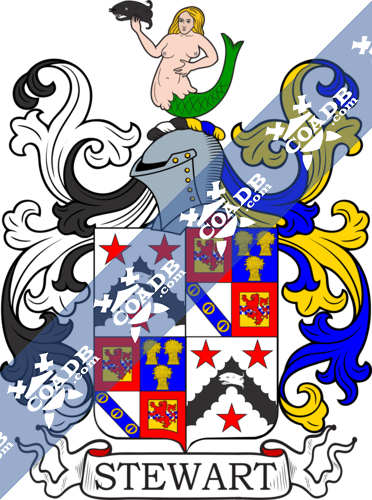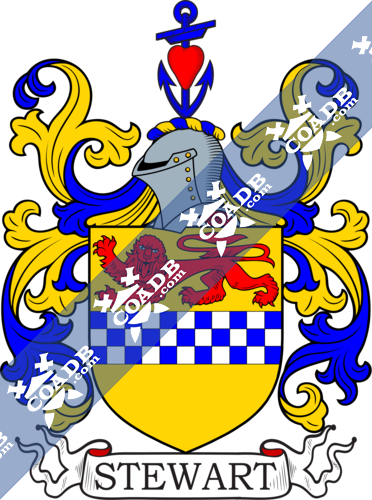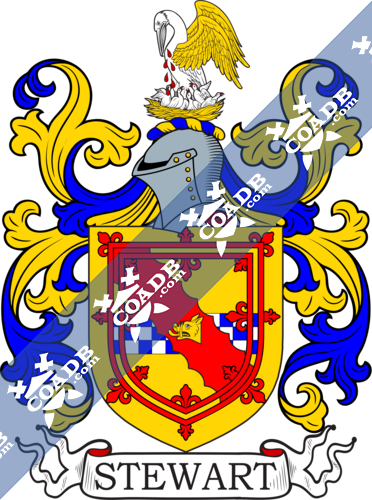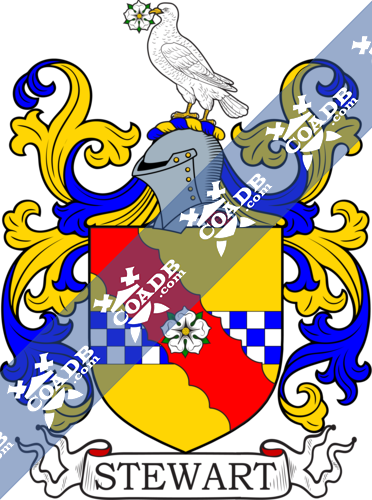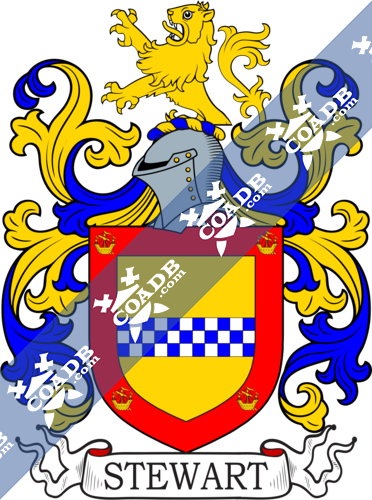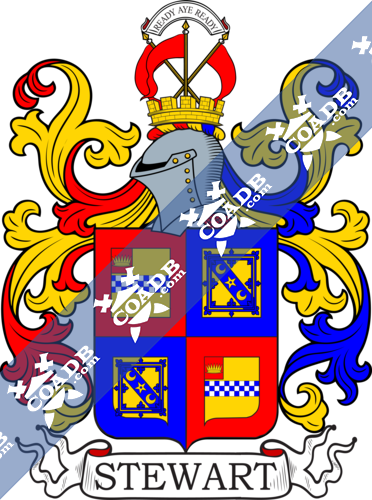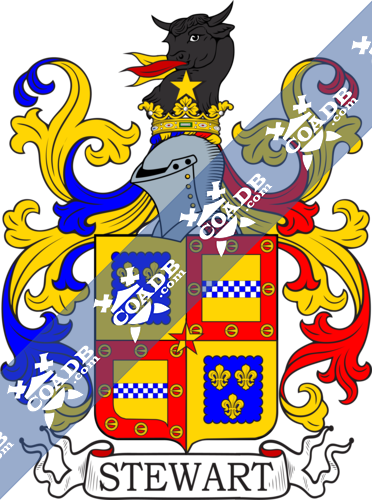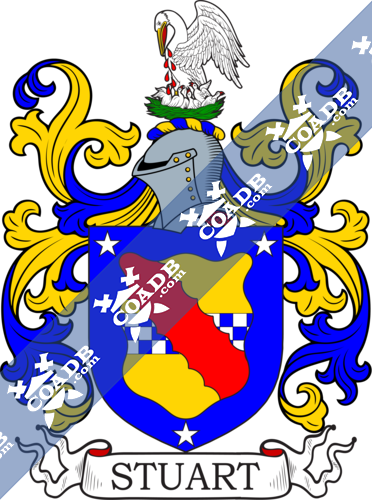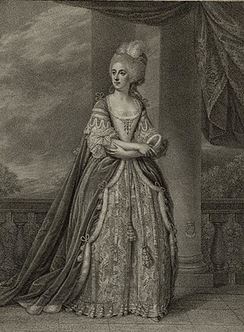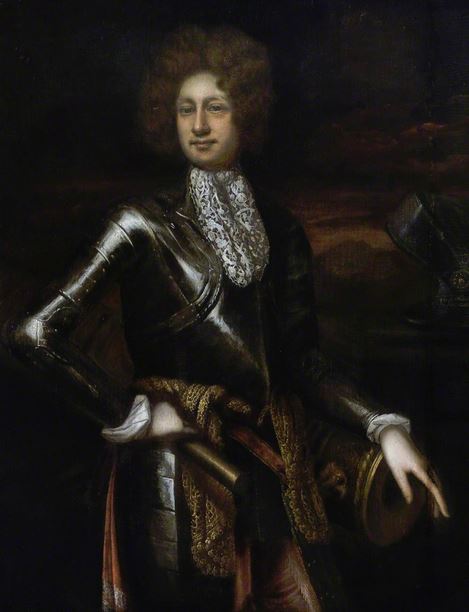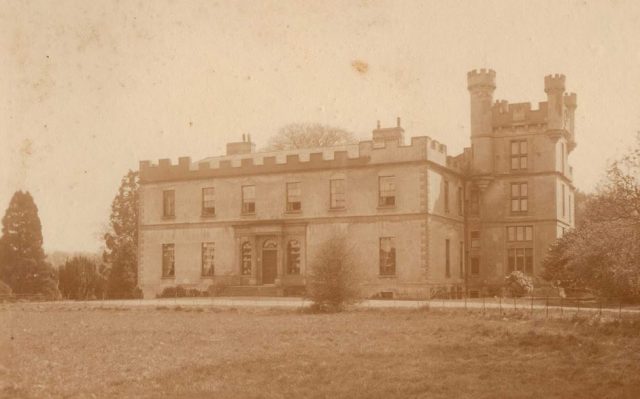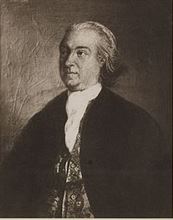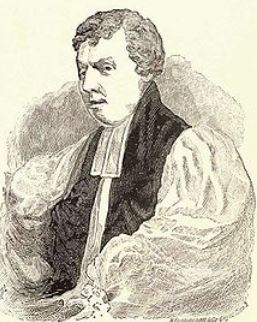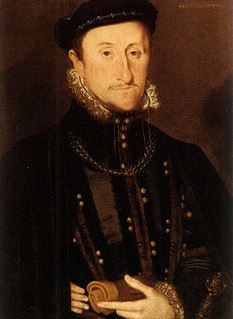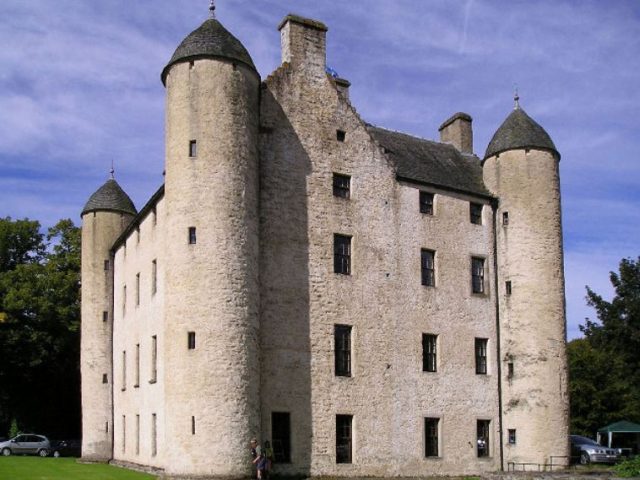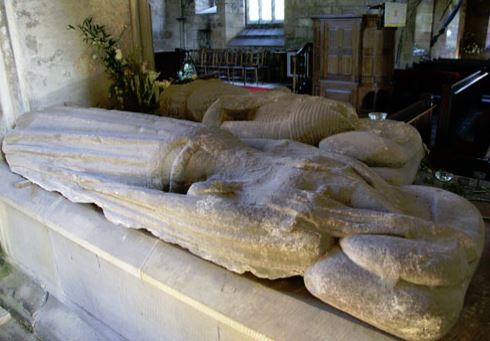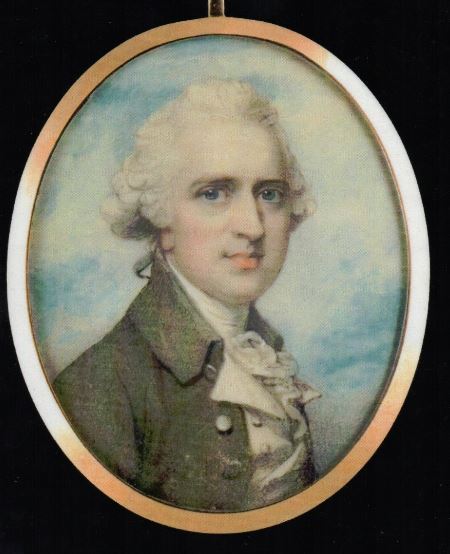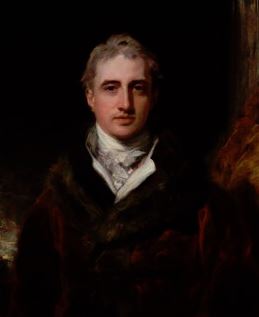Stewart Family Crest, Coat of Arms and Name History
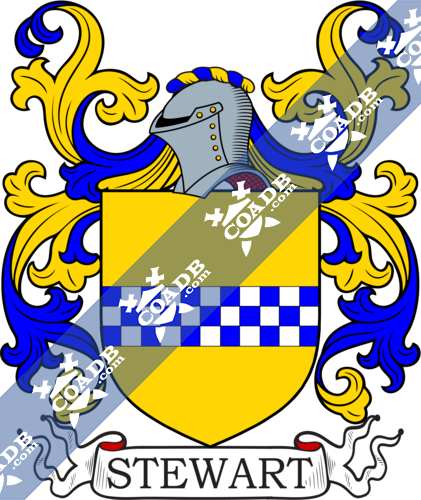
Stewart Coat of Arms Gallery
Don’t know which Coat of Arms is yours?
We can do a genealogical research. Find out the exact history of your family!
Learn MoreSurname Name Meaning, Origin, and Etymology
This Scottish and English last name Stewart and Stuart are sharpened versions of the surnames Steward and Stuard. The aforementioned names have two origin theories. First, it may be a baptismal surname meaning “the son of Steuhard or Stuard”. Second, it is likely an occupational surname from the office of “the steward”, a powerful position in medieval times where a servant supervised the lord’s estate and his household, an administrative official of a state or house, and often had a mandate to govern and represent the royal monarch. It derives from the Middle English word steward and Old English word stigweard or stiweard, a compound of stig (household) and weard (guardian). It is related to the Old Norse word stiuardr, a guardian or keeper.
The book Some Scotch Surnames by C. Innes states, “It was not till after several generations that the Fitz-Walters and Fitz-Alans took that name [Stewart], destined to become so illustrious, from their office of steward of the royal household”.Starting in the 1200s AD, it became a very important title in Scotland, known as the Steward of Scotland, which was the highest rank in the kingdom below that of King or Queen. The book An Etymological Dictionary of Family and Christian Names by William Arthur states, “Walter, the son of Fleance, and grand-son of Banquo, was created, by Malcom III. Lord High Steward of Scotland, from which office his family afterward took and retained ‘the name of Stewart, and from them descended the royal family of Stuart”.
Mark Antony Lower’s Patronymica Britannica states the following: “Alan, the son of Flaald, a man of whose paternal ancestry and nation nothing is clearly known, and who died very early in the XII cent., was the common parent of William Fitz-Alan, ancestor of the Earls of Arundel, and of Walter Fitz-Alan,
Steward of Scotland, whose great-grandson, Alexander, assumed Stuart as his surname, and was the ancestor of the royal race of that dynasty. From the latter of these sons springs Queen Victoria, and from the former, her Majesty’s highest temporal subject, the Duke of Norfolk, premier peer of the realm. Whatever may have been the male ancestry of Flaald, it is certain that he was descended on his mother’s side from the old Princes of Wales and from the ancient Saxon Earls of Mercia.”
The surname is discussed at length in George Fraser Black’s “The Surnames of Scotland”, published in 1946, a brief excerpt of which is as follows: “In 1315 he had married Marjory, daughter of King Robert the Bruce, who bore to him a son, Robert, afterwards Robert II, first of the royal line of Stewart, crowned in 1371. Many people imagine that all persons bearing the name Stewart (or its variants) are of royal descent, but it must be borne in mind that there were stewards and stewards, as King James the Sixth emphasized when he said that all Stewarts were not ‘sib’ to the king”.
The surname was brought from Scotland to England by Alan, a knight who settled in Shropshire.
Clan Stewart
Clan Stewart is as Highland Scottlish clan recognized by the Court of the Lord Lyon and the Earls of Galloway are considered to the principal branch of this clan. The crest is a pelican, winged or, nest feeding her young. It’s plant badge is thistle and it’s pipe music is Bratach Bhan nan Stiubhartach (The white banner of the Stewarts). They descended from the senschals of Dol in Brittany France and became to monarchs of Scotland. After the Norman Invasion of England in 1066 AD, the Stewarrs acquired great estates as the Fitz-Alan family. James Stewart, 5th High Steward of Scotland, swore loyalty to King Edward I of England, but later sided with William Wallace and Robert the Bruce during the Wars of Scottish Independence. Walter, the 6th High Steward, married a daughter of King Robert the Bruce named Marjory, and when Robert’s son diued, he was succeeded by Walter’s son: Robert II. Robert II had many issue, including John, who succeeded to the throne as Robert III. The Stewart male line was uninterrupted until the reign of Mary Queen of Scots. They held the thone of Scotland and later England until 1714 when Queen Anne of Great Britain passed away. Further, the Dukedom of Albany is a peerage titled bestowed upon younger sons in the Scottish/British royal family, particularly in the House of Stuart. There are several branches of the clan, including Stewart of Appin, Stewart of Atholl, Stewarts of Balquhidder, and Stuarts of Bute. There are numerous castles the family was associated with or seated at, including most notably Edinburgh Castle, Stirling Castle, Castle Stuart, and Linlithgow Castle.
Spelling Variations
Common spelling variants or names with similar etymologies include Stuart, Steuart, Steward, Stuard, Stewards, Steuhard, Stewardson, Staward, Stuarde, Stiwar, Stiwerd, and Stewhard. The name is the equivalent of the French-Norman surname Seneschal, a person who administered affairs for a royal or noble household. Foreign equivalents include Stigaard (Danish), Steyaert/Stuywaert/Styaert (Flemish), and Sturtz (German). The Gaelic form is Stiubhard or Stillbhard.
Popularity & Geographic Distribution
The last name ranks Stewart ranks 54th in popularity in terms in the United Status as of the 2000 Census. The name ranks particularly high in the following five states: Ohio, Mississippi, Alabama, Kentucky, West and Virginia. The surname is also very common in England, where it ranks 76th. It ranks highest in the following counties: Northumberland, Durham, and Cumberland. The name is common throughout the English speaking world: Scotland (6th), Wales (121st), Ireland (365th), Canada (26th), New Zealand (18th), Australia (39th), and South Africa (347th).
The last name ranks Stuart ranks 883rd in popularity in terms in the United Status as of the 2000 Census. The name ranks particularly high in the following nine states: Utah, Mississippi, Oregon, Arkansas, Maine, Idaho, New Hampshire, Alaska, and Vermont. The surname is also very common in England, where it ranks 501st. It ranks highest in the following counties: Cumberland, Northumberland, and Middlesex. The name is common throughout the English speaking world: Scotland (174th), Wales (121st), Ireland (1,243rd), Canada (751st), New Zealand (210h), Australia (359th), and South Africa (888th).
A few other spelling variants of the surname also rank in the US Census of 2000, which records about the 150,000 most common last names in the country. The name Steward ranks 1,533rd in the United States, Stuard ranks 22,967th, Steuart ranks 41,712th, and Stewardson ranks 69,167th.
Early Bearers of the Surname
A one Roger de Stiwerd was documented as living in Devon between 1100-1130 AD. The Domesday Book lists Alwinus Stiward in 1148 AD in Hampshire. The Rotuli Charyurm lists one Reginald le Stiward in 1205 AD in Dorset.
The Hundred Rolls of 1273 AD, a census of Wales and England, known in Latin as Rotuli Hundredorum lists one bearer of this surname: Marin Steuhard in county Norfolk. A one William le Fiz Stywarde was listed in Berwick in 1296 AD. The Poll Tax of Yorkshire in 1379 AD lists one bearer of this last name: Willemus Stuard. Nicholas Staward was recorded in county Somerset in Kirby’s Quest during the reign of King Edward III of England (1327-1377), as was one Adam Staward. The Register of the University of Oxford lists one John Steward (or Stuarde) in county Northampton in 1581. Brand’s Newcastle mentions one Richard Stewardson, under-usher of Grammar Schhol attached to St. Mary’s Hospital, Newcastle-on-Tyne. An early marriage involving this surname was Joseph Stewardson to Elizabeth Bland at St. George’s Hanover Square in 1800. Early baptisms involving this last name include John, son of Robert and Edy Steward, at St. James Clerkenwell in 1723, as well as Jane, daughter of Robert and Ede Stewart in 1723 at the same church.
History, Genealogy, and Ancestry
The earliest recorded ancestor of this family is Frotmundus Vetules Bretagne, who was born in 960 AD in Ille et Vilaine, France. He had a son named Flaald Fratmaldus Dol in 1005 AD in St. Malo, Bourgogne. He married Constance de Dol and Ava de Norton. He had a son named Alain De Dol Gitz Flaald, known as Sir Alain Fitz Flaald and Dapifer of Dol, born around 1016 AD. He married Adeliza Seneschal and had a son with her named Fledaldus de Dol prior to his death in the Kingdom of Jerusalem. Fledaldus was born in 1046 AD and he married three times: Guneta Verch Griffith, Domina Norton, and Filia Rex Scotiae. He had several children, including Alan Fitz-Flaald. Alan Fitz-Flaald was born in 1075 AD in Bretagne. He married Aeline Hesdid and had several sons prior to his death in Shropshire, England. One son was Walter Fitz-Alan, the 1st High Steward of Scotland, who was born in 1105 AD. He married twice: Eschina Loudin and later Helen Peverel. He had numerous issue, including Alan Fitz-Walter. Alan, 2nd High Steward of Scotland, was born in 1150 AD in Paisley, Scotland. He had numerous issue, including Walter Stewart, who was born in 1170 in the same town in Renfrewshire. He married Bethox Angus, and had numerous issue with her, including Alexander. Alexander Stewart, 4th High Steward, was born in 1214 in Dundonald, Scotland. He married Jean Macrory and had numerous issue with her. One of his sons was named James Stewart, who was born in 1242 in Argyll. He married Cecilia Dunbar and Egidia Burgh and had the following issue: Edward, Andrew, Walter, John, Egidia (Menzies), and James. His son Walter was born in 1292 AD and was the 6th High Steward. He married three times: Alice Erskine, Marjorie Bruce, and Isabel Graham. He had the following children: Jean, Maude, Robert II, John, Thomas, Egidia (Lindsay), and Andrew. His son Robert Stewart II was born in 1316 AD and became King of Scotland. He married four times: Marion Cardny, Joan Isaac, Elizbeth O’Rowallan, and Euphemia Ross. He had the following children: Alexander Katherine, James, John, Walter, Robert, Margaret, Alexander, Elizabeth (Hay), Isabella Euphame (De Bruce), Alexander, Jean, Isabel (Edmonston), Egidia, Marjoria, David, Egidia, Isabell, John, Thomas, Walter, Elizabeth, John, Katherine (Mazwell), Catherine, and John.
The famous genealogist Bernard Burke’s book “The Landed Gentry” discusses 20 branches of this family: 1) Steuart of Auchlunkart, 2) Steuart of Ballechin, 3) Steuart of Dalguise, 4) Gow-Steuart of Fowler’s Park, 5) Steuart of Steuart Hall, 6) Steward of Newton Manor, 7) Steward of Nottington House, 8) Stewart of Ardvorlich, 9) Stewart of Cairnsmore, 10) Murray-Stewart of Broughton, 11) Stewart of Garvocks, 12) Stewart of Ballymenagh, 13) Stewart of Murdostoun, 14) Stewart of Horn Head, 15) Stewart-Menziers of Chesthill and Foss, 16) Stewart of Physgill, 17) Stewart of St. Fort, 18) Stewart or Urrard, and 19) Stewart of Coll.
The first begins with a mention of Andrew Steuart, Esquire of Auchlunkart House in county Banff who was Justice of the Peace, Deputy Liuetnant, and a member of Parliament for Cambridge who was born in 1822. In 1847, he married Elizabeth, daughter of Lieutenant Colonel Thomas Gordon and had children with her. Burke traces the lineage of this line back to Alexander Steuart of Stradown, who claimed descent from the House of Atholl. The Stewart family crest is blazoned as follows in heraldry: Or, a fess chequy, azure and argent, between in chief three crosses-crosslet fitchee and in base as many cushions of the second.
The second branch begins with a mention of John Steuart, Esq. of Ballechin in county Perth who was Justice of the Peace born in 1837. In 1862, he married Caroline Anna, daughter of Sir Albert de Hochepied Larpent, and had the following children with her: John Malcolm Steuart (1863), Francis Gerald, Robert Henry Joseph, Bernard Charles Albert, Patrick Hope, Gertude Katherine Mary Angela, and Veronica Mary Isabel. The family, until the death of its representative in 1876, had an unbroken succession in the male line of the some four centuries, is descended from Sir John Steuart, of Sticks, in Glenquaich, in county Perth, who was the son of King James II of Scotland. The Steuart Coat of Arms is blazoned in heraldry as follows: Quarerly, 1st and 4th, or, a lion rampant gules armed and langued azure within a double tressure flory counterflory of the second, as descended of the Royal Family of Scotland; 2nd and 3rd, or, a fess chequy azure and argent; all within a border engrailed per pale or and argent.
The third branch begins with a discussion of John Steuart, Esquire of Dalguise in county Perth, who was a Justice of the Peace, Deputy Lieutenant, and High Sheriff of the Colony of the Cape of Good Hope since 1829. He was born in 1799 and in 1829, he married the Honorable Janet Oliphant Murray, daughter of Alexander, 8th Lord Elibank, and had issue with her including Margaret Henrietta Maria Janet, Charlotte Amelia Sophia, Caroline Jane, Amelia Helen, and Clara Mary Montoliue. Burke traces the genealogy of lineage to Sir John Steuart, of Arntuille and Cardneys, the youngest natural son of King Robert II of Scotland. The Steuart Family Crest as given on a monument in Dunkeld Cathedtral built in 1620: Quarterly, 1st and 4th, or, a fess chequy argent and azure; 2nd and 3rd, or a lion rampant gules within the royal tressure of the last. But by the charter issues in 1771 from the Lyon Office, the arms of John Steuart Esq., of Dalguise, the eighth in descent from Sir John Steuart, are stated to be, or, a lion rampant gules between three mullets azure, over all a fess chequy argent and of the third.
The fourth branch begins with a mention of Herbert John Stewart Gow-Steuart, Esquire of Fowler’s Park in Kent, England who was born in 1854. The lineage is traced back to the Gow family, a surname in Gaelic that is synomous with that of Smith in English.
The fifth branch begins with a mention of David Steuart, Esquire of Steuart Hall in county Stirling, a Captain of the 34th regiment who was born in 1830. In 1861, he married Dorothy Emily, daughter of Reverend John Cox, Rector of Fairsted, Essex, and had two issue with her: Robert John and Mary Helen. The Steuart Coat of Arms has the following heraldic blazon: Or, on a fess chequy sable and argent over all a lion rampant gules within a bordure ermine.
The sixth branch begins with a mention of Anthony Benn Steward, Esquire of Newton Manor, Cumberland, Justice of the Peace, and High Sheriff in 1858 who married Mary Anne, daughter of Milham Hartley of Rose Hill. He was the son of John Steward of Chapel House. The Steward Coat of Arms is blazoned as follows: Or, a fess chequy argent and azure within a bordure ermine.
The seventh branch begins with a mention of Richard Oliver Francis Steward, Esq. of Nottinghouse, Dorset, a Lieutenant Colonel, who was born in 1823. In 1856, he married Olivia Elizabeth, daughter of Sir Henry Allen Johnson. Burke claims the family is of Scotch origin and emigrated to St. Helena in the 18th century and settled at Weymouth. Gabriel Steward, son of Gabriel Steward and Sarah Wrangham, married Rebecca, daughter and co-heir of Richard Tucker, and had numerous issue with her: Gabriel Tucker, Richard Augustus, Reverend Edward Tucker, John Charles Tucker, Rebecca, and Sarah Dorothea, and Maria. The Steward Family Crest is blazoned as follows: Or, a fess chequy azure and argent surmounted of a bend gules within a bordure of the last.
The eighth branch of the family begins with a discussion of Alexander John Robert Stewart, Esq. of Ards in county Donegal and Laurencetown House in county Down. He was Justice of the Peace for Donegal, Down, and Middlesex, Deputy Lieutenant for Donegal and Down, and Sheriff for Donegal in 1853. He was born on 1827 and in 1851 he married Lady Isabella Rebeccea Graham, daughter of Hector John Graham, 2nd Early of Norbury, and had eight children with her: Alexander George John, Charles Hector, George Laurence, Henry Moore, Cecil George Graham, Caroline Helen Mary, Beatrice Charlotte Elizabeth, and Ida Mary Augusta. Burke traces the lineage of Stewart genealogy back to Alexander Stewart, Esq. who was born in 1746, the son of Alexander Stewart of Mount Stewart in county Down. The Stewart Family Crest is blazoned as follows: Quarterly: 1st and 4th, or, a bend compony argent and azure between two lions rampant gules, for Stewart; 2nd and 3rd, gules, a saltire argent. They were seated in Ards, Letterkenny and Laurencetown House, Gilford. The line is also related to Stewart of Rockhill.
The ninth branch begins with a mention of Robert Stewart, Esq. of Ardborlich in county Perth of the Bengal army, late Superintendent of Cachar, and Commissioner, Assam, born 1829, and in 1860 married Charlotte Joanna, daughter of Anthony Murray, and had a daughter with her named Charlotte. The genealogy or pedigree traces back to Robert, Duke of Albany, son of Robert III of Scotland, who married Margaret, Countess of Menteith and had a son with her named Murdoch. Murdoch was Duke of Albany and Regent of Scotland who married Isabella, Countess of Lennox. He was beheaded in 1425 and his surviving son was James Stewart, who fled to Ireland and had several children. The Stewart Coat of Arms has the following blazon in heraldry: Quaterly, 1st and 4th, or, a lion rampant within a double tressure flory counterflory gules; 2nd, or a fess chequy azure and argent in chief a mullet gules; 3rd, argent, a saltier engrailed between four roses gules barded and seeded vert all within a bordure engrailed componee azure and of the first.
The tenth branch mentioned is Murray-Stewart of Broughton, and is discussed under the Murray section of the book.
The eleventh branch is Stewart of Cairnsmore. It begins with Colvin Stewart, Esquire of Cairnsmore, Kirkcudbright, who was born and was a Major Scottish Borders. In 1867, he married Julia Henrietta Mary, daughter of James Coape of Mirables, Isle of Wight. Burke traces this Stewart ancestry back to James Stewart, of Cairnsmore, Kirkbudbright, who was Justice of the Peace and Deputy Lieutenant born in 1791. In 1829, he married Elizabeth, daughter of Gilbert MacLeod of Gloucester Place and had issue with her: Colvin, Patrick (Lieutenant Colonel), Keith (Lieutenant in the Royal Navy), and Gilbert MacLeod
The twelfth branch begins with a discussion of James Stewart, Esq. of Garvocks in county Renfrew and St. Fillans, county Ayr for was elected Member of Parliament for Greenock in 1878. He was born in 1827 and in 1855 he married Margaret Parker, daughter of Major Darroch of Gourock, and had three children with her: James William, Susan Caroline, and Margaret Parker Darroch. Burke traces the Stewart pedigree or genealogy back to Daniel Stewart, born 1720, who in 1786, married Helen Love, with whom he had the following issue: James and William (of St. Fillaus in county Ayr). The heraldic arms for Stewart are blazoned as follows: Or, a fess chequy azure and argent between a horseshoe sable in chief and a lymphad, sails furled, oars in action, flags an pennon flying all proper in base.
The thirteenth branch begins with a discussion of Reverend Edward Michael Stewart of Ballymenagh, county Tyrone and Corcam county Donegal who was born in 1797. In 1833, he married Jane Renwick, daughter of John Jeffrey, with whom he had issue: Reverend Henry William (Rector of Knockbreda), Rev. John Alexander, Pakenham Edward, William, Charlotte, Elizabeth, and Katherine Caroline Isabella. Inb the early reign of King James VI of Scotland and of England, James Stewart migrated from Scotland and purchasing Cookstown, county Tyrone and the adjacent lands from one Cook, settled himself at Ballymenagh, while his brother, Andrew Stewart, ancestor of the Sir John Stewart, of Athenry, created a Baronet, 1803, settled at Gortigal, in the same county James had two sisters, Barbara (married Reverend William Danagh) and Grissel (married Richardson of Clogher). They family resided at Ebrington Terrace, Londonderry.
The fourteenth branch is Stewart-Menziers of Chesthill and Foss. It is discussed under the Menzies section of the book.
The fifteenth branch mentioned begins with a discussion of Robert King Stewart, Esquire of Murdostoun Castle in county Lanark who was born in 1853. His ancestors were occupiers of the same property in Stair parish in county Ayr, for several hundred years, and were cadets of the Stewarts of Carrick in that county. Robert Stewart, Edsquire of Stair in county Ayr married Mary Herbert and had a won with her named William. William was a merchant in Glasgow who in 1808, married Helen Millar and had several issue with her. The Stewart Coat of Arms is blazoned as follows: Or, a fess chequy azure and argent surmounted by a lion rampany proper all within a bordure invected of the second. They were seated at Murdostoun Castle in Wishaw, county Lanark.
The sixteenth branch begins with a discussion of Charles Frederick Stewart, Esquire of Horn Head in county Donegal, who was Justice of the Peace, who succeeded his father in 1868. In 1869, he married Elizabeth Frances, daughter of the late Reverend Thomas Lindesay, Rector of Upper Cumber, and had the following six children with her: Charles Frederick, William, Thomas Francis, Anne Elizabeth Frances, Nichola Mary, and Walter Edward. This family is of ancient Scottish ancestry, and is of the Lennox Stewarts, Earls of Darnley. Captain Charles Stewart was an officer in the army of King William III, and fought at the Battle of Boyne, and received a grand of lands in Doone, in King’s County, from the King, but migrated north in 1700 and purchased the Donegal estates of Horn Head and others. He left children: Frederick, Charles, Gustavus of Ray, and Eleanor (married Benson of Lundford). The Stewart Family Crest is blazoned as follows Quarterly, 1st and 4th, azure three fleurs-de-lis within a bordure engrailed or; 2nd and 3rd, or a fess chequy azure and argent within a bordure gules charged with eight buckles of the first, over all in the centre chief point a mullet counterchanged.
The seventeenth branch begins with a mention of Robert Hathorn Johnson, Esquire of Physgill in county Wigton in Justice of the Peace and born in 1824. He succeeded his uncle in 1841 and assumed the additional surname of Johnston. He was an officer in the 93rd Highlanders, and Captain in the 13th Light Dragoons, educated at Eton. In 1851, he married Eleanor Louisa, daughter of Archibald Douglas of Glenfinart, and had two children with her: Stair Hathorn Johnston and Ellen Douglas (married J.F. Dalrymple Hay). He later married Anne Murray, daughter of Sir William Maxwell, 6th Baronet of Monreith, and had eleven issue with her: Robert, William Maxwell, James, Mary, Margaret, Nora, Blanche, Annie, Constance, and Edith. Both the families of Physgill and Glenturk descend from John Stewart, Minister of Kirkmahoe, son of Sir Alexander Stewart of Garlies. The Stewart Coat of Arms is blazoned in heraldry as follows: Or, a fess chequy azure and argent surmounted of a bend engrailed gules; in the sinister chief point of the fourth, all within a double tressure flory counterflory also of the fourth.
The eighteenth branch is Stewart of St. Fort and begins with a mention of Jane Stewart, of St. Fort of county Fife, daughter of the late James Fraser, Esq. of Culduthell in county Inverness. She was born in 1796, and in 1837, she married Henry Stewart and had two sons with him: Robert Balfour (1838) and James Affleck (1839). This is a branch of the royal House of Stewart. John Stewart, the first of Urrad, son of Robert Stewart of Fincastle, was lineally descended from John Stewart, progenitor of the Athol Stewarts, 4th son of Alexander, Lord Badenoch, Earl of Buchan, 4th son of King Robert III. This genealogical line bore the following arms: Or, a fess chequy azure and argent surmounted of a lion rampant gules all within a bordure engrailed of the second charged with three garbs of the field alternately with as many crescents of the third.
The nineteenth branch of the family begins with a mention of Francis Louisa Alston-Stewart of Urrard in county Perth who was born in 1833. In the 1850s, she married Benjamin Hallowell Boxer and had issue with him: William Edward Hallowell (1852), Herbert Ramsay (1854), Leslie Rinrory (1859), Aubrey Keith (1861), Claude Percival (1863), Amy Evelyn, and Beatrice Adelaide. The Stewart Family Crest has the following blazon: Quarterly, 1st and 6th, azure ten stars, four, three, two, and one or, a border embattled gules, for Alston; 2nd, or, a fess chequy azure and argent, surmounted of a lion rampant gules a border of the last, for Stewart of Urrard; 3rd, azure three garbs or, for Comyn; 4th argent, on a bend azure three buckles or, for Leslie; 5th gyronny of eight or and sable, for Campbell.
The twentieth branch begins with a mention of John Lorne Stewart, Esquire of Breachacha, Isle of Coll, who was Justice of the Peace born in 1837. He served in the Scots Greys and 18th Hussars and was a Major in the army. Burke traces the genealogy back to John Lorne Stewart, Esq. of Breachacha Isle of Coll and Knockriock. He was Justice of the Peace and Deputy Lieutenant who was born in 1830. In 1831, he married Mary, daughter of Archibald Campbell, and had two sons with her: Duncan (born 1834, married Ferooza Margaret, daughter of Right. Honorable Sir John McNeill) and John Lorne. They were seated at Breachaeha.
Early American and New World Settlers
James Steward arrived at Plymouth in 1621 aboard the Fortune. William Steward arrived in the Barbados aboard the Expedition in November 1635 at the age of 21. John, son of John and Margaret Steward, was baptized in June of 1679 in the parish of St. Michael’s, Barbados. A one John Stuard and his wife, who owned eight slaves and had one servant, were registered in the town of St. Michael’s, Barbados.
Early colonial Americans bearing this last name include Austin Stewart (Boston 1651), Charles Stewart (Boston 1652), Margaret Stewart (Virginia 1705), Malcolm Stewart (Virginia 1716), Alexander Stewart (South Carolina 1716), Don Stewart (Georgia 1738), Robert Stuart (Virginia 1652), Sarah Stuart (Virginia 1701), and Alexander Stuart (New England 1734). Two of the earliest settlers in Canada bearing this surname include Gilbert Stuart (Nova Scotia 1760) and Andrew Stewart (Nova Scotia 1749). In Australia, some of the earliest settlers were Edmund Stewart, who settled in New South Wales in April 1822 and came aboard the Asia and John Stuart (a maker of cabinets) who arrived in Tasmania between 1825-1832. In New Zealand, Richard Stuart settled in Wellington in 1840 and A. (Alexander?) Stewart arrived in New Zealand in 1840.
Early American Bearing the Stewart Family Crest
Charles Knowles Bolton’s American Armory “A record of coats of arms which have been in use within the present bounds of the United States”, published in 1927, contains five entries for the names Stewart.
1) Or a fess chequy az and arg Crest: a lion ramp gu. Supporters: A white horse and a deer. Motto: Avito vir et honore. Framed water color at Brook Hill, Henrico Co., Va. The Misses Stewart. Seen by Lawrence Park.
2) Or a fess chequy az and arg surmounted by a bend engr arg within a double tressure [gu?] Crest: a pelican in her piety [the nest vert]. Bookplate Charles Samuel Stewart, Phila., 1810.
3) Quart 1 and 4: Or a fess chequy az and arg within a double tressure gu; 2 and 3: Quart 1 and 4: Or, 3 passion nails conjoined in point sa piercing a man’s heart in base gu (Logan); 2 and 3: Arg an eagle displayed sa [properly with 2 heads?] (Ramsey) Crest: a demi-lion ramp gu (?). Motto: Nobilis ira Bookplate Anthony Stewart, Annapolis, Md.
4) Quart 1 and 4: Or a fess counter-compony arg and az; 2 and 3: Arg a lymphad sa Crest: a horse’s head couped. Motto: Whither will ye Bookplate Duncan Stewart, Collector of Customs, New London, Conn. D. 1793 in London. Oliver West Ind. bookplates No. 248.
5) Quart 1 and 4: Or a less chequy gu and arg surmounted of a bend gu charged with 3 buckles or, in chief a lion pass gu; 2 and 3: Gu a chev bet 3 cranes’ heads erased or (Denham?) Crest: a thistle and a sprig of rosetree in saltire ppr. Motto: Juvant aspera probum Bookplate Redmond Conyngham Stewart. J. W. Spenceley, sc., 1902.
Mottoes
I have identified Stewart/Stuart family mottoes, as well as Steuart and Steward family mottoes. This is a very high number, and is likely in the top ten names with the most mottoes, rivaled only by surnames such as Smith and Brown.
1) A virtute orta – A power arisen
2) Avant Darnley – Forward, Darnley
3) Avito viret honore – He flourishes through the honour of his ancestors (Stuart de Decies and Stewart de Rothsay)
4) Beati pacifi – Blessed are the peace makers
5) Candide – With candor
6) Caraid ann am fheum – A friend in time of need
7) Christus mihi lucrum – Christ is my reward
8) Corde et manu – With heart and hand (Stewart of Carnhoise, Steuart of Auchlunkart)
9) Dat incrementum – Gives increase (God gives increase?)
10) Deo juvante vinco – I conquer by the help of God
11) Deus providebit – God will provide
12) Est nobilis ira leonis – The lions anger is noble (Stuart of Bute)
13) Forward (or Pass forward) – Forward
14) Furth fortune and fill the fetters – Furth fortune and fill the fetters
15) Hinc orior – From here I rise
16) I mean well – I mean well
17) Impero – Command (?)
18) Judge nought – Judge nought
19) Justitiæ propositique tenax – Tenacious of justice and of purpose
20) Juvant aspcra fortes – Difficulties delight the brave
21) Juvant aspera probum – Misfortunes benefits the good man (Steuart of Coltness)
22) Metuenda corolla draconis – The dragon’s crest is to be feared
23) My hope is constant in thee – My hope is constant in thee
24) Never fear – (Stewart Castlestwart and St. Fort)
25) Never unprepared – Never unprepared
26) Nil desperandum est – Nothing must be despair at.
27) Nobilis ira – Noble in anger (Stewart of Tillicoultry, Creighton-Stuart)
28) Nobilis unica virtus – Virtue if the only nobility (Steward of Nottingham)
29) Omne solum ferti patria – Every land is a brave man’s country
30) Pax copia virtus – Peace, plenty, valour
31) Presto et persto – I undertake and persevere
32) Pro rege et lege – For King and the law
33) Pro rege et patria – For king and country
34) Providentia fido – Trust in Providence
35) Provyd – Provide
36) Quhidder will zie – Whither will ye
37) Qui invidet minor est – He that envies is inferior
38) Ready aye ready – Ready aye ready
39) Reddunt commerica mitem – Commercial intercourse render man sociable
40) Resolve is power – Resolve is power
41) Semper paratus – Always ready
42) Sic fuit, est, et erit – Thus it has been, is, and will be (Stewart of Burgh)
43) Sic virescit industria – Thus industry flourishes
44) Singula cum valeant, sunt meliora simul – Take each of them asunder, good as either.
45) Sol tibi signa dabit – The Sun shall give you indications
46) Sola juvat virtus – Virtue alone delights
47) Soli Deo honor – Glory to God alone
48) Salus per Christum Redemptorem – Salvation through Christ the Redeemer
49) Spero meliora – I hope for better things
50) Spero infestis, muto secundis – I hope in adversity, I fear in prosperity
51) Stat felix amico Domino – His happiness is sure when the Lord is his friend
52) Stemmata quid faciunt – What uses are pedigrees (?)
53) Suffibulatus majores sequor – Being buckled, I follow my ancestors
54) Sur espérance – Upon hope
55) Tam fidus quam fixus – Equally faithful as steadfast
56) Virescit vulnere virtus – Courage becomes greater through a wound
57) Virtuti fortuna comes – Good fortune attendant on virtue
58) Virtutis in bello præmium – The reward of valour is war (Steuart of Allanton), This-motto alludes to the special augmentation o f arms granted by King Robert II of Scotland to this branch of the Steuart family as a reward for their distinguished and repeated services in defence of the liberty of their country.
59) Vulnere viresco – Through my wound, I grow strong
60) Laedere noli – Injure no man
Grantees
We have 123 coats of arms for the Stewart/Stuart/Steuart/Steward surname depicted here. These 123 blazons are from Bernard Burke’s book The General Armory of England, Ireland, and Scotland, which was published in 1848. The bottom of this page contains the blazons, and in many instances contains some historical, geographical, and genealogical about where coat of arms was found and who bore it. People with this last name that bore a Stewart Coat of Arms include:
1) Ambrose Steward, Harbord of Great Yarmouth, county Norfolk, and Stoke Park, county Suffolk (1834)
2) of New York. Match with Brenton (1812)
3) Honorable Sir William Stewart Lieutenant-General, 1813, supporters with the consent of his brother, the Earl of Galloway
4) Stewart to Vane (1819? Charles William), Baron Stewart 1 July 1814, Earl Vane, 28 March 1813
5) Vane to George, Henry Robert Charles William, Supporters, Baron Stewart, Earl Vane, succeeded his father on 6 Marc 1854 as Earl of Vane and Viscount Seaham
6) Stewart-Murray, minor, or Scotland, 1846
7) Murray, now Murray-Stewart, of Scotland, 1855
8) Charles Poyntz Stewart, son of Philip
9) John Stuart, Baron Cardiff, 20 May 1776, commonly called Lord Mount-Stuart, Supporters 1776
10) The Honorable Sir Charles Stuart, Lieutenant-General, brother to Marquess of Bute, Supporters 1776
11) Sir Charles Stuart, K.B., 26 September 1812, invested 1813, Envoy Ex. to Portgula, father of Lord, created Baron, Stuart de Rothesay
12) Sir John Stuart, Major-General, Knight, order of the Crescent, County Maida, Crest for augmentation (1804)
13) Stuart, now Wortley, Royal License 1795, James Archibald, second son of the 3rd Earl of Bute
14) Stuart-Worthley-MacKenzie, Royal License 17 June 1826, James Archibald, Baron Whatncliffe, 12 July 1826, of county York and Scotland.
15) Stuart after Crichton, Royal License 26 August 1805, John Stuart, 7th Earl of Dumfries
16) after Crighton, 21 March 1817, Patrick James Herbert, 2nd son of Baron Mountsuart
17) Stuart, Crichton, 26 August 1805, John, 2nd., Marguess of Bute, Herbert Coat, 1822
18) Stuart after Fenwick, Spr. Of London, March 1816
19) Stuart-Forbes, of Scotland, 1821
20) Stuart, after Villiers, of Bramfield, county Hertford, Waldersham, county Kent and Dromana, county Waterford, Ireland (1822)
21) Stuart, de Decies, Baron Stuart (1839, Henry Villiers-Stuart), Supporters, 1839
22) Stuart, after Gordon, of London and Scotland (1835)
23) Stuart, Sir James, Bart., Chief Justice of Lower Canada (1841)
24) Stuart and Durand, of London, and Malacea (1847)
25) Stuart-Forbes, Hepburn, Forbes, before Trefusis, 4 September 1867, Hepburn-Stuart, Forbes-Fresusis, Baron Clinton, of Scotland, 1867.
Notables
There are thousands of notable people with the Stewart surname. This page will mention a handful. Famous people with this last name include: 1) Dugald Stewart (1753-1828) who was a Scottish philosopher and mathematician who popularized the Scottish Enlightenment and lectured at the University of Edinburgh, 2) Kordell Stewart (1972) who was a Quarterback in the National Football League (NFL) from 1995 to 2005, 3) Kristen Jaymes Stewart (1990) who is an American actress and model best known for her role in the Twilight Saga, 4) Mary Stuart (1542-1587) who was Mary I of Scotland, known as Wueen of Scots who reigned over Scotland from 1542-1567, 5) Mary Stewart (1428-1465) who was Countess of Buchan who married Wolfert VI of Borselen, 6) William Payne Stewart (1957-1999) who was an American golfer who won 11 PGA Tour events, 7) Robert Charles Stuart (1920-2005) who was a New Zealand rugby player and coach, 8) Gilbert Charles Stuart (1755-1828) who was an American painter from Rhode Island, and 9) Alexander Hugh Holmes Stuart (1807-1891) who was the 3rd Secretary of the Interior during the Fillmore and Pierce presidential administrations.
Blazons & Genealogy Notes
Stewart – (James, Earl of Murray, Regent of Scotland, son of James V. by dau. of fourth Lord Ershine). Quarterly, 1st and 4th, the arms of Scotland debruised by a riband sa; 2nd and 3rd, or, three cushions pendent within a double tressure flory counterflory gu. Crest—A pelican feeding her young or, in her nest vert. Supporters—Two greyhounds ar. collared or. Motto—Solus per Christum Redemptorem. See Earl of Moray, as now borne, under Stuart.
Stewart – (Earl of Orkney; from Robert, Abbot of Holyrood House, son of James V. by dau. of first Lord Elphinstone). Quarterly, 1st and 4th, the arms of Scotland debruised by a riband sa.; 2nd and 3rd, az. a galley at anchor within a double tressure flory counterflory or, for Orkney. Crest—A king enthroned, holding in his dexter hand a sword, In his sinister a falcon all ppr. Supporters—Dexter, a unicorn az.; sinister, a griffin ppr. Motto—Sic fuit est et erit.
Stewart – (Earl of Carrick, younnger son of the Abbot of Holyrood House, and Earl of Orkney). Quarterly, 1st and 4th, Scotland, within a bordure compony az. and ar.; 2nd and 3rd, Orkney, as above. Crest, Motto, and Supporters, as the last.
Stewart – (Newark; from natural son of the first Earl of Orkney). Or, a fess chequy az. and ar. within a bordure giu charged with three lions ramp. and as many ships at anchor interchanged of the first. Crest—A lion’s paw and palm branch in saltire ppr. Motto—Christus mihi lucrum.
Stewart – (Alexander, Duke of Albany, second son of James II.). Quarterly, 1st, Scotland; 2nd, gu. a lion ramp. ar. within a bordure of the last, charged with eight rosea of the field, for the Earldom of March; 3rd, gu. three legs conjoined in the fess point in armour ppr. garnished and spurred or, for Man; 4th, or, a saltire and chief gu., for Annandale. Supporters—Two bears, muzzled, collared, and chained ppr.
Stewart – (Alexander, Earl of Mar, third son of Jakes II.). Quarterly, 1st and 4th, Scotland; 2nd and 3rd, az. a bend betw. six crosslets fitchée or, for Mar; on surtout, or, a fess chequy az. and ar. betw. three ducal crowns gu.
“Stewart – (Ardgowan and Blackhall, bart., 1667; from natural son of Robert III.; now Shaw-Stewart). Quarterly, 1st and 4th, or, a fess chequy az. and ar. over all a lioa ramp, gu., for Stewart, of Blackhall; 2nd and 3rd, az. three covered cups or, for Shaw, of Greenock. Crest—1st: A lion’s head erased gu. armed and langued az.: 2nd: A demi savage wreathed about the head and middle with
aurel, and holding a club over his shoulder ppr. Supporters—On the dexter, a lion ramp. gu. armed and langued az. gorged with a collar chequy ar. and of the third; and on the sinister, a savage wreathed round the head and middle with laurel leaves, and holding a club over his shoulder all ppr. Motto—Over the crests: Spero meliora; and, I mean well.”
Stewart – (Scotstown; uncle of first bart. of Blackhall). Or, a lion ramp. gu. surmounted of a fess chequy az. and or, in the dexter canton a crescent. Crest—A bow’s head couped ar. Motto—A virtute orta.
Stewart – (Duke of Albany and Earlof Fife and Menteith, second son of Robert II.). Quarterly, 1st and 4th, ar. a lion ramp gu., for the Earldom of Fife; 2nd and 3rd, or, a fess chequy az. and ar., for Stewart, over all a label of five points gu. in chief.
Stewart – (Lord Evandale and Ochiltree). Quarterly, 1st, Scotland; 2nd, or, a fess chequy az. and ar. with a label of three points gu. in chief; 3rd, ar. a saltire cantoned with four roses gu., for Lennox; 4th, or, a lion ramp, gu., for the Earldom of Fife, all within a bordure compony az. and ar. Crest—A civet cat pass. ppr. (sometimes, a unicorn’s head ar. armed and crined or, betw. two olive branches ppr.). Supporters—Two dragons vert. Motto—Forward (sometimes. Pass forward).
Stewart – (Earl of Arran, second son of Lord Ochiltree). Quarterly, 1st and 4th, the coat of Ochiltree, without the bordure; 2nd and 3rd, counter-quartered, Hamilton and Arran. Crest—A lion’s head erased gu. Supporters—Dexter, a dragon vert; sinister, an antelope ar. armed or. Motto—Dat incrementum.
Stewart – (Lord Methven). Quarterly, as Lord Ochiltree, with, en surtout, gu. a lion ramp. holding in his forepaws a tower ar., for the Lordship of Methven. Crest—A tower ar. Supporters—Dexter, a dragon vert; sinister, a greyhound ar. Motto—Forward.
Stewart – (Baldorran, co. Stirling, and Ardvorlich, co. Perth). Quarterly, 1st and 4th, Scotland; 2nd, Stewart, in chief a mullet gu.; 3rd, Lennox, all within a bordure engr. compony az. and ar. Crest—A dexter arm ppr. grasping a sword in bend sinister also ppr. hilted and pommelled or. Motto—Deo juvante vinco.
Stewart – (Annat). As Ardvorlich, with a mullet sa. in the centre of the quarters.
Stewart – (Earl of Buchan, known as the “Wolf of Badenoch”). Or, a fess chequy az. and ar. with a mullet in dexter chief.
Stewart – (Earl of Mar, natural son of the “”Wolf of Badenoch ”). Quarterly, 1st and 4th, or, a fess chequy az. and ar. betw. three crowns gu.; 2nd and 3rd, az. a fess betw. fix cross crosslets fitchée or, for Mar. Crest—Two serpents nowed erect counter-respectant ppr. Supporters—Two lions ramp. guard.
Stewart – (Strathdown or Strathaven, co. Banff; from a natural son of the “Wolf of Badenoch,” as recorded 1776). Quarterly, 1st and 4th, or, a fess chequy az. and ar. betw. two antique crowns in chief gu. and a boar’s head couped in base sa.; 2nd and 3rd, az. a bend betw. six cross crosslets fitchee or, for Mar. Crest—A demi lion ramp. ppr. Motto—Nobilis ira.
Stewart – (Drummin, co. Banff, 1672). Or, a fess chequy az. and ar. betw. three cross crosslets fitchée in chief and as many cushions of the second in base, all within a bordure of the last. Crest—Two hands conjoined holding a man’s heart ppr. Motto—Corde et manu.
Stewart – (Garth, co. Perth; from a natural son of the “Wolf of Badenoch”). Quarterly, 1st and 4th, or, a fess chequy az. and ar. surmounted by a lion ramp. gu.; 2nd and 3rd, az. three garbs or, for Comyn, the feudal coat of the Earldom of Buchan.
Stewart – (Dundee, cadet of Garth, 1680). Quarterly, as the last, within a bordure ar. charged with six wolves’ heads erased gu. Crest—A savage’s head ppr. Motto—Reddunt commerica mitem.
Stewart – (Urrard, co. Perth, cadet of Garth; co-heiress to. Richardson, of Pitfour, Hay, of Seggieden, and Major James Alston). Quarterly, 1st and 4th, or, a fess chequy az. and ar. surmounted by a lion ramp. gu. a bordure of the last; 2nd, omyn; 3rd, ar. on a bend az. three buckles or, for Leslie.
Stewart – (Castle Stewart, afterwards St. Fort, co. Fife). Or, a fess chequy az. and ar. surmounted by a lion ramp. gu. a bordure engr. of the second charged with three garbs of the field alternately with as many crescents of the third. Crest—A dexter arm from the elbow holding a dagger in pale ppr. Motto—Never fear
Stewart – (Stewart-Balfour) (younger son of St. Fort by dau. of Balfour, of Dunbog, 1837). Quarterly, 1st and 4th, ar. on a chev. engr. sa. betw. three stars gu. an otter’s head erased of the field, for Balfour; 2nd and 3rd, counterquartered, as Urrard. Crest—A mermaid ppr. in her dexter hand an otter’s head erased sa. Motto—Omne solum ferti patria.
Stewart – (Ladywell, 1672). Quarterly, as Garth, within a bordure ar. Crest—A man’s head couped ppr. Motto—Pro rege et patria.
Stewart – (Earl of Strathearn, eldest son of Robert II marriage with Euphemia Ross; said to be represented by Mrs. Barclay Allardice as heir of line). Or, a fess chequy az. and ar. betw. two chevronels gu. a double tressure flory counterflory of the last.
Stewart – (Walter, Lord of Brechin, Earl of Caithness and Earl of Athole, younger son of Robert II. and Euphemia Ross). Quarterly, 1st, Scotland, with a label of three points; 2nd, paly of six or and sa., for Athole; 3rd, ar. three, piles in point gu., for Brechin; 4th, ar. a lion ramp. az. for Galloway; en surtout, az. a ship under sail or, for Caithness. Crest—A lion sejant guard. gu. with a sword erect ppr. in his dexter paw. Supporters—A hart gorged and chained, and a lady.
Stewart – (Hereditary Sheriffs of Bute; descended from Sir John Stewart, natural son of Robert II, ancestor of the Earls and Marquesses of Bute, for whom see Stuart). Or, a fess chequy az. and ar. betw. three lions ramp. gu.
Stewart – (Ascog, co. Bute, 1672). Or, a fess chequy az. and ar. within a bordure sa. charged with eight mascles of the third.
Stewart – (Roslane, co. Bute, 1672). Or, a fess chequy ar. and ar. in chief a lion pass, guard, gu. Crest—An anchor in pale az. ensigned with a man’s heart ppr. Motto—Tam fidus quam fixus.
Stewart – (Dugald Stewart, of Catrine, the Metaphysician, 1807). Or, a fess chequy az. and ar. within a bordure gu. charged with three crescents of the third. Crest—The rising sun issuing out of a cloud ppr. Motto—Sol tibi signa dabit.
Stewart – (Ralston, co. Ayr; from the son of Walter, the High Steward, husband of Majory Bruce, by his second wife, Isabel Graham). Or, a fess chequy az. and ar. in chief a lion pass. gu.
Stewart – (Sir John Stewart, brother of Sir James Stewart, fifth High Steward, husband of the heiress of Bonkyl, and ancestor of some of the most considerable branches of the family). Or, a fess chequy az. and ar. surmounted of a bend gu.
Stewart – (Earl of Darnley, Earl and Duke of Lennox, and Lord of Aubigne, in France; descended from Alexander, second son of Sir John Stewart, of Bonkyl). Quarterly, 1st and 4th, az. three fleurs-de-lis or, within a bordure engr. ar. for the Lordship of Aubigne; 2nd and 3rd, or, a fess chequy az. and ar. within a bordure gu. charged with three buckles of the field, for Stewart; en surtout, ar. a saltire betw. four roses gu., for Lennox. Crest—Issuing out of a ducal coronet or, a bull’s head sa. vomiting forth flames ppr. Supporters—Two wolves ppr. Motto—Avant Darnley.
Stewart – (Earl of Galloway; descended through an heiress from Sir Walter Stewart, of Dalswinton and Garlies, third son of Sir John Stewart, of Bonkyl, and said to be paternally from Sir John Stewart, of Jedworth, fourth son of Sir John Stewart, of Bonkyl). Or, a fess chequy ar. and az. surmounted of a bend engr. gu. within a tressure flory counterflory of the last. Crest—A pelican ar. winged or, in her nest, feeding her young ppr. Supporters—Dexter, a savage wreathed about the head and loins with laurel, holding a club over his dexter shoulder all ppr.; sinister, a lion gu. Motto—Virescit vulnere virtus.
Stewart – (Nateby Hall, co. Lancaster, 1867). Quarterly, 1st and 4th, as Earl of Galloway, within a bordure engr. erm.; 2nd and 3rd, per fess dovetailed erm. and sa. three falcons belled, one and two, counterchanged, for Thomson. Crest and Motto, as Earl of Galloway.
Stewart – (Castle Stewart, in Galloway). As Earl of Galloway, the bend charged with a boar’s head couped or, for diff. Crest and Motto, as Earl of Galloway.
Stewart – (Burray, co. Orkney, bart., 1687). Or, a fess chequy az. and ar. surmounted of a bend engr. gu. a bordure of the last. Crest—A pelican volant ppr. Motto—Virescit vulnere.
Stewart – (Physgill, co. Wigtown; as recorded 1740). Or, a fess chequy az. and ar. surmounted of a bend engr. gu. in the sinister chief point a buckle of the fourth, all within a double tressure flory counterflory also of the fourth. Crest—A demi lion ramp. holding in his dexter paw a buckle or. Motto—Suffibulatus majores sequor.
Stewart – (Ballymorran, co. Down). As the last, with an escallop sa. in dexter base for diff. Crest—A demi lion ramp. guard. ppr. holding in hie dexter paw a buckle or. Motto, as the last.
Stewart – (Earl of Blessington). Gu. a feas chequy ar. and az. betw. three lions ramp. or. Crest—A dexter hand in armour holding a heart all ppr. Supporters— Dexter, a man in complete armour garnished or, with three feathers in his cap, the middle one gu. the others ar.; sinister, a qneen in royal vestments gu. girded or, over all a mantle purp. doubled erm. her feet naked, hair dishevelled, and ducally crowned or. Motto—Nil desperandum est.
Stewart – (Fort Stewart, bart. of Ireland, 1623). As the last, without the supporters.
Stewart – (Minto, co. Roxburgh). Or, a fess chequy az. and ar. surmounted of a bend engr. gu. in sinister chief a rose of the last.
Stewart – (Shambelly, co. Dumfries; as recorded 1732). Or, a fess chequy az. and ar. surmounted of a bend engr. gu. charged with a rose ppr. Crest—A dove with a rose in his beak ppr. Motto—Soli Deo honor.
Stewart – (Lord of Lorn and Innermeath, and Earl of Athole; descended from Sir James Stewart, of Pierston, fifth son of Sir John Stewart, of Bonkyl). Quarterly, 1st and 4th, or, a fess chequy az. and ar. in earlier times differenced by a buckle gu. or a garb az. in chief, for Stewart; 2nd and 3rd, or, a lymphad sa. sometimes represented with St. Anthony’s fire at the masthead), for Lorn. Crest—A unicorn’s head ar. horned or. Motto—Quhidder will zie.
Stewart – (Appin, co. Argyll). Quarterly, 1st and 4th, Stewart; 2nd and 3rd, ar. a galley, sails trussed up and oars in action sa., for Lorn.
Stewart – (Ardsheal, co. Argyll). As the last. Crest—A unicorn’s head ar. maned, horned, and bearded or. Supporters—Two roebucks ppr. Motto—Quhidder will zie.
Stewart – (Earl of Athole; from Sir John Stewart, of Balveny, son of the “Black Knight of Lorn,” and brother uterine of James II.; the dau. and heir of the last Earl m. the second Earl of Tullibardine). Quarterly, 1st and 4th, paly of six or and sa., for Athole; 2nd and 3rd, Stewart. Crest—A dexter hand holding a key in bend sinister ppr. Supporters—Two savages in fetters ppr. Motto—Furth fortune and fill the fetters.
Stewart – (Earl of Buchan: from James Stewart, second son of the “Black Knight of Lorn”). Quarterly, 1st and 4th, Stewart; 2nd and 3rd, az. three garbs or, for Comyn. Crest—A dexter hand ppr. holding a club raguly vert. Supporters—Two storks ar. beaked and membered gu. Motto—Judge nocht.
Stewart – (Earl of Traquair, from a legitimated son of James Stewart, first Eart of Buchan; title extinct or dormant from 1861). Quarterly, 1st, Stewart; 2nd, Comyn; 3rd, sa. a mullet ar.; 4th, ar. an orle gu. in chief three martlets sa. beaked of the second. Crest—A crow ppr. Supporters—Two bears ppr. armed ar. Motto—Judge nought.
Stewart – (Grandtully, co. Perth, cadet of Innermeath; aa recorded 1672). Quarterly, 1st and 4th, Stewart; 2nd and 3rd, ar. a lymphad, oars in action sa. Crest—Two bees counter-volant ppr. Motto—Provyd. For Arms as now borne, see Steuart.
“Stewart – (Fingorth, co. Perth, 1672). Quarterly, 1st and 4th, or, a fess chequy az. and ar. betw. three garbs of the
second; 2nd and 3rd, or, a galley, oars in saltire sa. Crest—A bee volant en arricrc ppr. Motto—Providentia fido.”
Stewart – (Overdowally, co. Perth, 1740). As the last, within a bordure embattled az. charged with eight buckles or. Crest and Motto, as Grandtully.
Stewart – (Rossyth, co. Fife; descended from Robert, younger son of Sir RobertStewart, of Shanbothy and Innermeath). Or, a fess chequy az. and ar. within a bordure of the second, charged with eight buckles of the first. Crest—A dexter arm front the elbow ppr. the hand holding a buckle or. Supporters—Two lions.
Stewart – (Kirkhill, and Strabrock, said to be from Rossyth; ended in co-heiresses, who m. the tenth Earl of Glencairn and third Earl of Cardross). Quarterly, Stewart and Comyn. Crest—A phoenix in a flame of fire ppr. Motto—Virtuti fortuna comes.
Stewart – (Craigiehall, co. Linlithgow, 1672). Quarterly, 1st and 4th, or, a fess chequy az. and ar. in chief three buckles of the second; 2nd and 3rd, erm. on a fess sa. three crescents ar., for Craigie.
Stewart – (Provost of Aberdeen; descended of Craigiehall, 1732). Quarterly, 1st and 4th, Stewart, with a mullet az. in base, quartered with Craigie, as above; 2nd and 3rd, quarterly, as Gordon, Earl of Huntley, within a bordure sa. charged with eight bezants. Crest—A basket full of fruit ppr. Motto—Deus providebit.
Stewart – (Halrig, co. Ayr, and East Binny, a very early cadet). Or, a fess chequy az. and ar. in base a bugle sa.
“Stewart – (Marquess of Londonderry). Quarterly, 1st and 4th, or, a bend compony ar. and az. betw. two lions ramp. gu., for Stewart; 2nd and 3rd, gu. a saltire ar. Crest—A dragon statant, wings elevated or. Supporters—Dexter, a Moor wreathed about the temples ar. and az. holding in the exterior hand a shield of the last, garnished or, charged with the sun in splendour gold; sinister, a lion or, gorged with a plain collar ar. thereon three mullets sa. Motto—Metuenda corolla draconis. See Vane-Tempest, Earl Vane
and Marquess of Londonderry.”
Stewart – (Bigtowne, co. Orkney, 1672). Or, a fess chequy az. and ar. betw. three mascles of the second. Crest—A holly leaf slipped vert. Motto—Sic virescit industria.
Stewart – (Lower Canada, 1834). Or, a fess chequy az. and ar. within a bordure gu. charged with four lymphads with oars in action of the first. Crest—A demi lion ramp. ppr Motto—Nobilis ira.
Stewart – (Capt. W. L. Stewart, 1st Royals, 1851). Quarterly, 1st and 4th, or, a fess chequy az. and ar. within a bordure gu. on a canton of the last an Eastern crown of the field; 2nd and 3rd, or, on a bend az. a mullet pierced betw. two crescents of the field, within a double tressure flory counterflory of the second, a bordure of the last, for Scott. Crest—On a mural crown or, three lances disposed saltireways ppr. pennoncels gu. Mottoes—Over the crest: Ready aye ready; below the shield: Resolve is power.
Stewart – (Caledon Park, co. Lanark, 1868). Per bend or and ar. a fess chequy az. and of the second, in chief a stag’s head couped of the third. Crest—A pelican in her nest feeding her young gu. Motto—Vulnere viresco.
Stewart – (Athenry and Ballygawley, co. Tyrone, bart., 1803). Quarterly, 1st and 4th, or, a lion ramp. within a double tressure flory counterflory vert; 2nd and 3rd, or, a fess chequy ar. and az. in chief a portcullis sa. the whole within a border gobony ar. and vert. Crest—A unicorn’s head couped or, armed and crined ar. Motto—Stemmata quid faciunt.
Stewart – (Ards, co. Donegal; descended from Alexander Stewart, brother of Robert, first Marquess of Londonderry). Quarterly, 1st and 4th, or, a bend compony ar. and az. betw. two lions ramp. gu., for Stewart; 2nd and 3rd, gu. a saltire ar. Crest—A dragon statant or. Motto—Metuenda corolla draconis.
Stewart – (Fun. Ent. Ulster’s Office, 1661, Lieut.-Col. Robert Stewart, buried in St. Bride’s Church). Quarterly, 1st and 4th, or, a fess chequy ar. and az. a label of three points gu.; 2nd and 3rd, ar. a saltire engr. sa. betw. four cinquefoils gu. all within a border compony ar. and az.
Stewart – (impalement Fun. Ent. Ulster’s Office, 1657, Sir Robert Hannay, Bart., of Mocrum, Scotland). Or, a fess chequy ar. and az. a border gobony of the second and third.
Stewart – (Hornhead. co. Doneg.il; descended from Captain Charles Stewart, of Doone, in the King’s co., who purchased lands in co. Donegal, a.d. 1700). Quarterly, 1st and 4th, az. three fleurs-de-lis or, a border engr. of the last; 2nd and 3rd, or, a fess chequy az. and ar. on a border gu. eight round buckles, tongues fessways of the first, over all in the fess point a mullet quarterly gu. and or. Crest— Out of a ducal coronet or, a bull’s head sa. flames issuing from the mouth ppr. charged on the neck with a mullet gold. Motto—Avant Darnley.
Stewart – (Killymoon, co. Tyrone; confirmed by Hawkins, Ulster, 1783, to James Stewart, Esq., of Killymoon). (Stranorlar, co. Donegal: confirmed by Fortescue, Ulster, 1799, to Henry Stewart, Esq., of Stranorlar, second sen of William Stewart, Esq., of Killymoon). Quarterly, 1st, or, a lion ramp. gu within a tressure fiory counterflory of the last, for Stewart; 2nd, or a fess chequy ar. and az., also for Stewart; 3rd, ar. a saltire engr. sa. betw. four roses gu. seeded and barbed gold; 4th, az. alion ramp. ar. ducally crowned or, all within a bordure compony ar. and az. Crest—A griffin’s head couped ppr. Motto—Forward.
Stewart – (Hamill-Stewart, Ballyatwood House, co. Down; exemplified to John Thomas Stewart, Esq., only son and heir of John Stewart, Esq., Deputy Remembrancer of the Court of Exchequer, Ireland, by Harriet Louisa, his wife, dau. and co-heiress of Hans Mark Hamill, Esq., of Ballyatwood, on his assuming, by royal licence, 1865, the additional surname of Hamill). Quarterly, 1st and 4th grand quarters, quarterly, 1st and 4th, or, a lion ramp. az. within a double tressure flory counterflory yert, 2nd and 3rd, or, a fess chequy ar. and az. the whole within a bordure gobony ar. and vert, a crescent gu. for diff., for Stewart; 2nd and 3rd grand quarters, quarterly, 1st and 4th, gu. a fleur-de-lis or, 2nd and 3rd, az. a crescent ar., for Hamill. Crests—1st, Stewart: A unicorn’s head couped or, horned and crined ar. a crescent gu. for diff.; 2nd, Hamill : A fleur-de-lis or. Motto—Forward.
Stewart – (Blankeney-Lyon- Stewart, Ballymenagh, co. Tyrone). Quarterly, 1st and 4th, or, a lion ramp. gu. a canton sa. thereon a fess chequy ar. and az., for Stewart; 2nd, per fess ar. and az. a lion ramp. within a double tressure flory counterflory all counterchanged, for Lyon; 3rd, sa. on a chev. engr. ar. betw. three leopards’ faces’ or, three crescents of the field, for Blakeney. Crests—1st, Stewart: Out of an embattlement ppr. a demi lion ramp. gu.; 2nd, Lyon: Within two branches of laurel a lady to the girdle, habited in white, holding in her dexter hand a thistle and in her sinister a trefoil all ppr.; 3rd, Blankeney: Out of clouds ppr. an arm erect couped at the elbow, vested per pale or and az. and charged with an escallop counterchanged, in the hand ppr. a dagger also ppr. hilted and pommelled or. Motto—Forward.
Stewart – (Blundeston, co. Suffolk). Quarterly, or and ar. on a fess az. three fleurs-de-lis of the first, in the 1st and 4th quarters a fess chequy of the second and third, and in the 2nd and 3rd quarters a lion ramp. gu. debruised by a bend raguly or. Crest—On a mount vert within a crown vallery or, a lion ramp. gu. Motto—Presto et persto.
Stewart – (Stewart-Murray) (exemplified to Horatio Granville Stewart, Esq., of Broughton, co. Wigton, upon his assuming the additional surname of Murray). Quarterly, 1st and 4th, for Stewart, or, a fess chequy ar. and ax. a bend engr. gu. all within a tressure flory counterflory of the last; 2nd and 3rd, for Murray, az. three mullets ar. a canton of the last for diff. Crests— 1st, Stewart: A pelican in her piety ppr.; 2nd, Murray: A gryphon salient ppr. charged on the shoulder with a cross crosslet az. for diff. Motto—Impero.
Stewart – (co. Somerset ; granted 1595). Chequy ar. and sa. a fess gu. a border az. Crest—A triple plume of ostrich feathers intermixed, alternately ar. and sa.
Stewart – (Charles Stewart, Esq., late M.P. for Penryn and Falmouth, descended from Wester Cluny, Scotland, 1879). Quarterly, 1st and 4th, or, a fess chequy az. and ar. sur. mounted of a lion ramp. gu.; 2nd and 3rd, az. three garbs or, all within a bordure ar. charged with three wolfs’ heads erased gu. (This quartered coat now counter-quartered with Stewart, of Grandtully, q. v.) Crest—A savage’s head ppr. Motto—Never unprepared.
Stewart – (Binny, co. Linlithgow, paternally Falconer). Or, a fess chequy az. and ar. in chief a mullet gu. in base a hunting horn sa. garnished and stringed of the fourth. Crest—A dexter hand holding a dagger point downwards ppr. Motto—Candide.
Stewart – (Lieut.-Gen. Sir Donald Martin Stewart, G.C.B., C.S.I., Commander-in-chief of H.M. Forces in India, bart., created 1881). Or, a fess chequy az. and ar. betw. in chief two garbs of the second, and in base an Indian crown gu. Crest—A dexter arm, couped below the elbow and erect, vested gu. holding in the hand a dagger ppr. hilted or. Motto over—Pro rege et lege.
Stuart – (Earl of Castle Stewart; the fifth Earl assumed the additional name of Richardson by royal licence, 1867). Quarterly, 1st, or, a lion ramp. gu. a double tressure flory counterflory of the last, for Scotland; 2nd, or, a fess chequy ar. and az. in chief a label of three points gu., for Stuart; 3rd, ar. a saltire betw. four roses gu., for Lennox; 4th, or, a lion ramp. gu., the whole within a border compony of the second and first. Crest—A unicorn’s head ar. armed or, betw. a pair of olive branches ppr. Supporters—Two dragons vert. Motto—Forward.
Stuart – (Earl of Moray). Quarterly, 1st and 4th, or, a lion ramp. within a double tressure flory counterflory gu. surrounded with a bordure gobony ar. and az. (as a descendant of the royal House of Stuaat); 2nd, or, a fess chequy az. and ar., for Stewart, of Doune; 3rd, or, three cushions, two and one, of a lozenge form, within a double tressure flory counterflory gu., for Randolph, Earl of Moray. Crest—A pelican in her nest feeding her young ppr. Supporters— Two greyhounds ar. collared gu. Motto—Salus per Christum Redempterem.
Stuart – (Duneam, co. Fife). As Earl of Moray, with a crescent sa. in the centre of the quarters for diff. Same Crest and Motto.
Stuart – (Lord St. Colm, younger brother of the “Bonny Earl of Moray”). Quarterly, 1st and 4th, or a lion ramp. gu., for Fife; 2nd and 3rd, or, a fess chequy az. and ar. within a double tressure flory counterflory gu. in chief a label of the last; en surtout, ar. on a mount vert a hart gu. attired ar. in front of a tree of the second, for St. Colm. Crest—A lion’s head erased gu. Supporters—Dexter, a lion gu.; sinister, a greyhound ppr. collared gu.
Stuart – (Inchbreck). Or, a fess chequy az. and ar. betw. a lion pass. in chief and a rose in base gu. a bordure engr. and compony of the second and third. Crest—A civet cat couchant ppr. Motto—Semper paratus.
Stuart – (Annat, co. Perth, 1802). As Stewart, of Ardvorlich [which see], with a mullet sa. in the centre of the quarters for diff.
Stuart – (Crichton-Stuart, Marquess of Bute). Quarterly, 1st and 4lh, or, a fess chequy az. and ar. within a double tressure flory counterflory go., for Stuart; 2nd and 3rd, ar. a lion ramp. az., for Crichton. Crests—1st: A demi lion ramp. gu., and over it the motto, Nobilis est ira leonis, for Stuart; 2nd : A wyvern, fire issuant from the mouth all ppr., for Crichton. Supporters —Dexter, a horse ar. bridled gu.; sinister, a stag ppr. attired or. Motto—Avito viret honore.
Stuart – (Dromana, co. Waterford; confirmed to Henry Villiers-Stuart, of Dromana, on his elevation to the Peerage as Baron Stuart de Decics, 1839). Quarterly, 1st and 4th, or, a fess chequy ar. and az. within a double tressure flory counterflory gu. a martlet for diff., for Stuart; 2nd and 3rd, ar. on a cross gu. five escallops or, for Villiers. Crests—1st: A demi lion ramp. gu.; 2nd: A lion ramp. ar. ducally crowned or. Supporters—Dexter, a horse ar. bridled gu. gorged with a wreath of shamrock vert; sinister, a stag ppr. gorged as the dexter. Motto—Avito viret honore.
Stuart – (Lord Stuart de Rothesay, extinct 1845). Or, a fess chequy az. and ar. within a double tressure flory counterflory gu. Crest—A demi lion ramp. gu. Supporters—A horse ar. bridled gu. and a stag ppr., each gorged with a collar flory counterflory gu. thereon a wreath of oak ppr. Motto—Avito viret honore.
Stuart – (Tillicoultry, co. Clackmannan, hart., 1707). Or, a fess chequy az. and ar. within a double tressure flory counterflory gu. in chief a cinquefoil erm. Crest—A demi lion ramp. ppr. Motto—Est nobilis ira leonis.
Stuart – (Castlemilk, co. Dumfries, bart., 1668; heir of line, W. Stuart-Stirling-Crawford, of Milton). Or, a bend gu. surmounted of a fess chequy az. and ar. Cresl—A dexter hand grasping a sword ppr. Motto—Avant.
Stuart – (Fettercaim, co. Kincardine; William Stuart, grandson of Sir Archibald Stuart, of Castlemilk, s. to the baronetcy conferred on his maternal grandfather, Sir George Wishart, a title which has in tbe course of seven generations descended through five heirs female, and now belongs to the Hon. C. J. R. Trefusis). As Castlemilk, with a crescent az. in chief.
Stuart – (Lord Blantyre). Or, a fess chequy az. and ar. surmounted of a bend engr. and in chief a rose gu. Crest—A dove with an olive leaf in its mouth ppr. Supporters —Dexter, a savage wreathed ataout his head and middle with laurel, and holding over his shoulder a club all ppr; sinister, a lion gu. Motto—Sola juvat virtus.
Stuart – (Hon. H. Constable-Maxwell-Stuart, of Traquair, and Scarthingwell, co. York). Quarterly, 1st, the quartered coat of the Earl of Traquair, within a bordure gu.; 2nd, ar. a two-headed eagle displ. sa. beaked and membered gu. bearing on his breast an escutcheon of the first, charged with a saltire of the second, surcharged with an urcheon or, for Maxwell, Earl of Nithsdale; 3rd, counterquartered, for Maxwell, Lord Herries, 1st and 4th, ar. a saltire sa. in chief a label of three points gu., 2nd and 3rd, ar. three urcheons sa.; 4th, quarterly, gu. and vair a bend or, for Constable. Crest—On a garb a crow ppr. Motto—Judge nought.
Stuart – (Harteley Mauduit, co. Hants, bart., 1660). Or, a fess chequy az. and ar. on an escutcheon ar. a lion ramp. gu. debruised by a bend raguly or. Crest—A stag statant ppr. gorged with a ducal coronet or. Motto—Singula cum valeant, sunt meliora simul.
Stuart – (Kilburn, co. Middlesex, 1811). Or, a fess chequy az. and ar. surmounted of a bend engr. gu. all within a bordure wavy az. charged with three mullets ar. Crest—A pelican in her nest feeding her young all ppr. Motto—Vircscit vulnere virtus.
Stuart – (Sir James Stuart, Bart., Chief Justice of Lower Canada, 1840). Or, a fess chequy az. and erm. betw. two crosses pattée in chief gu. and a thistle slipped and leaved ppr. a bordure of the second. Crest—In front of a demi lion holding in the dexter paw a thistle slipped and leaved, the Roman fasces paleways all ppr. Motto—Justitiæ propositique tenax.
Stuart – (Sheriff of Prince of Wales’ Island). Ar. a fess chequy or and az. surmounted of two bendlets indented gu. a bordure of the third charged with eight roses of the field. Crest—A dove reguard. ppr. holding in the beak a rose gu. resting its dexter foot on a bezant. Motto—Virtute.
Stuart – (Sir John Stuart, K.B., of Maida). Or, a fess chequy ar. and az. in base a hand couped in the act of striking with a dirk ppr. pommel and hilt or, on a canton gu. an estoile within an increscent ar. over all on a bend gu. a sword ppr. pommel and hilt or, being a representation of the sword presented to him by his Sicilian Majesty Ferdinand IV.
Stuart – (Aldenham Abbey, co. Herts). Or, a fess chequy az. and ar. within a double tressure flory counterflory gu. Crest—A demi lion ramp. gu. Motto—Avito viret honore.
Stuart – (Harrington-Stuart, of Torrance, co. Lanark). Quarterly, 1st and 4th, or, a bend gu. surmounted of a fess chequy az. and ar. a crescent of the second in chief for diff., for Stuart: 2nd and 3rd, sa. a fret ar. for Harrington. Crest—A dexter hand grasping a sword ppr. Motto—Avant.
Steward – (Okhey, co. Cambridge, Stuntney, Isle of Ely, Gestwait, Heseldon, and Swardeston, co. Norfolk, and co. Suffolk; granted 10 March, 1586). Ar. a lion ramp. gu. a bend ragulée or. Crest—A stag statant ppr. ducally gorged or.
Steward – (Patteshull, co. Northampton). Or, a fesa chequy ar. and az. a border erm. Crest—A stag ppr. gorged with a collar chequy ar. and az.
Steward – (Newton Manor, co. Cumberland). Or, a fess chequy ar. and az. a border erm. Crest—A stag ppr. gorged with a collar chequy ar. and az.
Steward – (Nottingham House, co. Dorset). Or, a fess chequy az. and ar. a bend gn. a border of the last. Crest—A pelican vulning herself ppr.
Steward – (co. Norfolk). Ar. a lion ramp. gu. a border engr. or.
Steward – Az. a chev. betw. three lions’ heads erased or.
Steward – Per chev. gu. and az. three lions’ heads erased or.
Steward – Gu. a chev. betw. three lions’ heads erased or.
Steward – Or, a chev. betw. three demi lions ramp. erased az. crowned or.
Steward – Gu. a chev. or, betw. three leopards’ faces ar.
Steward – (Ambrose Harbord Steward, Esq., of Stoke Park, co. Suffolk). Quarterly, or and ar. on a fess az. three fleurs-de-lis of the first, in the 1st and 4th quarters a fess chequy of the second and third, and in the 2nd and 3rd quarters a lion ramp. gu. debruised by a bend ragulee gold. Crest—On a mount vert, within a crown vallery or, a lion ramp. gu. Motto—Qui invidet minor est.
Steward – (Falcon-Steward, Newton Manor, Cumberland; exemplified to Rev. Robert Falcon-Steward, M.A., Rector of Sulhampstead, Berks, eldest son of Robert Falcon, M.D., by Margaret Steward, his wife, sister of Anthony Benn Steward, Esq., of Newton, on his assuming by royal licence in 1881 the additional surname and arms of Steward). Quarterly, 1st and 4th, Steward: Or, a fesse engr. chequy az. and ar. betw. two stags’ heads cabossed in chief and a round buckle in base of the second, all within a border erm.; 2nd and 3rd, Falcon: Sa. a chev. betw. two falcons close in chief and an annulet in base all ar., for Falcon. Crests—1st. Steward: A stag or, charged on the body with a buckle as in the arms, and resting the dexter foreleg on a stag’s head caboshed ppr.; 2nd, Falcon: On a rock ppr. and within an annulet in front thereof sa. a falcon close ar.
Steuart – (Auchlunkart, co. Banff). Or, a fess chequy az. and ar. betw. three crosses crosslet fitchée in chief and as many cushions in base of the second. Crest—A dexter and sinister hand holding up a heart ppr. Motto—Corde et manu.
Steuart – (Dalguise, co. Perth). Or, a lion ramp gu. betw. three mullets az. over all a fess chequy ar. and of the third. Crest—A demi lion ramp. ppr. Motto—Hinc orior.
Steuart – (Gow-Steuart, of Little Colonsay, Scotland, and Fowlers Park, co. Kent, 1868). Quarterly, 1st and 4th, as Dalguise, within a bordure gu.; 2nd and 3rd, vert on a fess ar. betw. a cat-a-mountain sejant guard, in chief and a dexter hand couped holding a dagger erect in base ppr. three holly leaves of the field, for Gow. Crests— A demi lion holding in his dexter hand a Lochaber axcppr., for Steaurt; A dexter arm in armour embowed holding in the hand a broadsword ppr., for Gow. Mottoes—Firm, for Steuart; and, Caraid ann am fheum, for Gow.
Steuart – (Steuart-Moncrieff) (Scotland, 1763). Quarterly, 1st and 4th grand quarters counterquartercd, 1st and 4th, ar. a fess chequy az. and ar. in chief a garb of the second, 2nd and 3rd, ar. a lymphad sa. the whole within a border engr. gu.; 2nd and 3rd grand quarters, ar. a lion ramp. gu. a chief erm. and a crescent az. in fess point, for Moncrieff. Crest—A unicorn’s head and neck ar. maned or, horned gu. Mottoes—Over the crest: Quhidder will zie; below the shield: Sur espérance.
Steuart – (Drummond-Steuart, of Grandtully, co. Perth, bart., 1683). Quarterly, 1st and 4th, or, a fess chequy az. and ar. betw. three buckles of the second in chief, and :i galley, oars in action sa. in base, for Steuart; 2nd, or, three bars wavy gu. within a bordure of the last, for Drummond; 3rd, the quartered coat of Mackenzie, Earl of Cromartie, within a bordure erm. Crest—Two bees counter-volant ppr., for Steuart; A dexter arm from the shoulder holding in the hand a broadsword all ppr., for Drummond. Mottoes—Provyd, for Steuart; Nil timeo, for Drummond.
Steuart – (Seton-Steuabt, of Allanton, co. Lanark, bart., 1815). Or, a fess chequy az. and ar. surmounted of a bend gu. charged with three buckles of the field, on a sinister canton of the fourth a lion pass. guard. gold, pierced with a dart ppr. (by special grant from King Robert II. of Scotland), and in base a broken spear surmounted of a helmet both ppr. Crest—Out of an earl’s coronet a dexter hand grasping a thistle all ppr. Supporters—Two lions ramp. guard. ppr. armed and langued gu. collared of the last, charged with three buckles or. Mottoes—Above the crest: Juvant aspcra fortes; under the shield: Virtutis in bello præmium.
Steuart – (Macdonald-Steuart, of Staffa, 1812, husband of the heiress of Touch and Allanton, and afterwards second bart. of Allanton). Quarterly, 1st and 4th, as the last, for Steuart; 2nd and 3rd, counter-quartered, 1st, ar. a lion ramp. gu., 2nd, or, a dexter arm in armour couped in fess ppr. the hand gu. holding a cross crosslet fitchée in pale of the last, 3rd, ar, a galley sa. moored in front of Fingal’s Cave, off the cliff of the Isle of Staffa, issuing from the dexter side ppr. and in the sea undy vert, in base a salmon naiart ar., 4th, ar. an oak tree vert surmounted of a two-headed eagle displ. or, all for Macdonald. Crest and Motto for Stedast, as above. Crest for Macdonald—A triple-towered castle ar. masoned sa. and issuing from the central tower a dexter arm in armour embowed grasping a broadsword all ppr. Motto—My hope is constant in thee.
Steuart – (Coltness and Goodtrees, bart., 1705). Quarterly, 1st and 4th, or, a fess chequy az. and ar. surmounted of a bend gu. charged with three buckles ar. in chief a lion pass. guard. of the fourth; 2nd and 3rd, gu. a chev. ar. betw. three cranes’ heads erased or, for Denham. Crest and Motto, as the last.
Steuart – (Coltness, co. Lanark, bart., 1689). Or, a bend gu. surmounted by a fess chequy az. and ar. all within a bordure chequy of the third and fourth. Crest—A thistle and a sprig of rose tree crossing each other in saltire ppr. Motto—Juvant aspera probum.
Steuart – (Alderston, co. Haddington, now Steuart-Grosset-Muirhead). Quarterly, 1st and 4th, or, a fess chequy az. and ar. in chief a lion pass. and in base three buckles gu.; 2nd, ar. on a bend az. three acorns or, for Muirhead; 3rd, az. three stars in fess ar. and as many bezants in fess or, below the middle of the field, in chief an acorn of the second, for Grosset. Crest—A hand holding a thistle ppr. Motto—Juvant aspera fortes.
Steuart – (McAdam-Steuart, of Glenormiston, co. Peebles, 1828). Ar. a fess chequy or and az. betw. three arrows in pale points upward in chief and three fleurs-de-lis, two and one, in base of the third. Crest—A branch of olive and one of Indian palm in saltire ppr. Motto—Pax copia virtus.
Steuart – (Ballechn, co. Perth; descended from Sir John Steuart, Knt., of Sticks, illegitimate son of James II., King of Scotland). Quarterly, 1st and 4th, or, a lion ramp. within a double tressure flory counterflory gu.; 2nd and 3rd, or, a fess chequy az. and ar. all within a bordure engr. of the first. Crest—A lion’s head erased gu. Motto—Semper fidelis.
Steuart – (Ballechin; as confirmed, 1876, to the heir of line and of entail, paternally Skinner). At above, bar the border engr. per pale or and ar. Same Crest and Motto.



